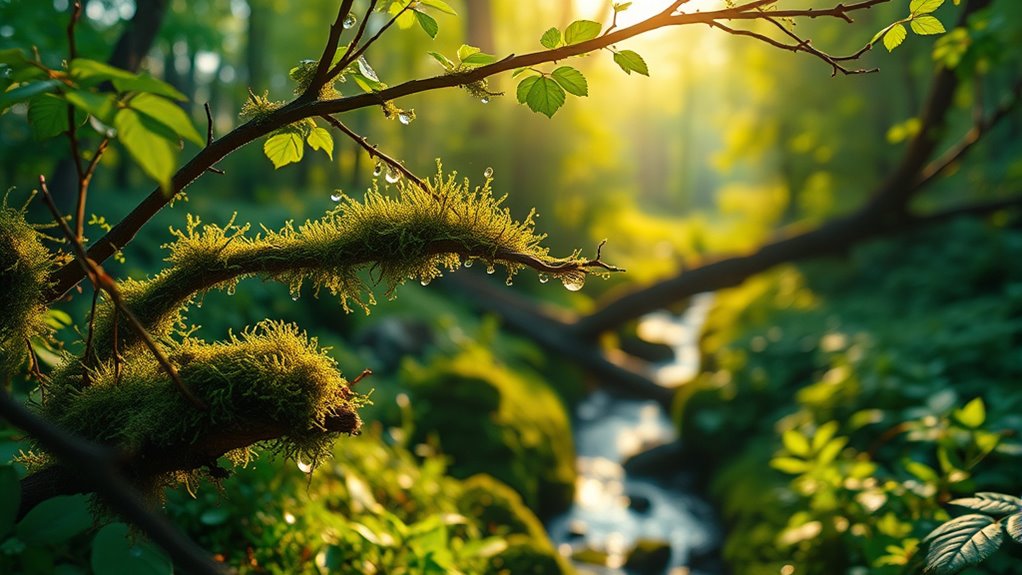If you’re looking for animated films that vividly showcase the outdoors, I recommend Safari: A Photicular Book for its mesmerizing moving images, The Art of Amphibia with its vibrant artwork and fun facts, Happy Feet 2 for its stunning 3D Antarctic landscapes and heartfelt story, and Wolf Children, which beautifully captures nature and emotion through touching storytelling. These selections combine great visuals with meaningful messages. Keep exploring, and you’ll discover even more ways to bring the natural world to life.
Key Takeaways
- Look for films with high-quality, detailed visuals and vibrant colors that realistically depict natural environments.
- Choose films that offer accurate, age-appropriate educational content about wildlife, habitats, and behaviors.
- Prioritize durable formats with interactive features like movable images or augmented reality to enhance engagement.
- Consider storytelling with relatable animal characters and meaningful themes that foster appreciation for nature.
- Assess long-term value by selecting well-made films that combine visual excellence, educational depth, and durability.
Safari: A Photicular Book
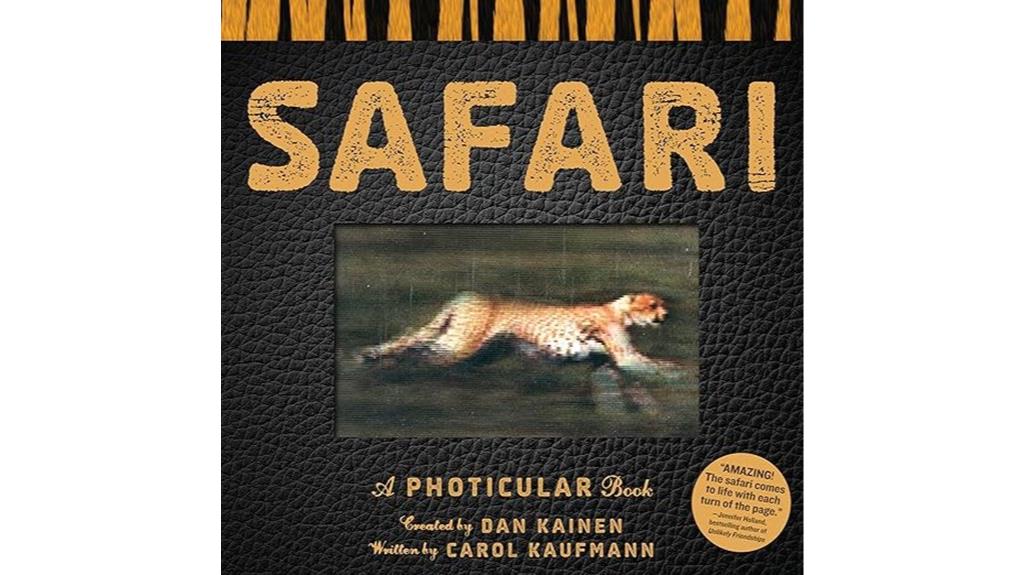
If you’re looking for an engaging and educational book for young children, Safari: A Photicular Book is an excellent choice because it combines stunning visual effects with informative content. The book uses lenticular images that create realistic illusions of animals in motion, making the scenes come alive as you turn the pages. It features animals like lions, giraffes, and elephants, with accompanying facts about their size, habitat, and diet. The thick, durable pages are perfect for little hands and long-term use. Kids are captivated by the mesmerizing movement, and parents love how it sparks curiosity about wildlife and nature, making it a treasured addition to any child’s library.
Best For: young children and early learners who are fascinated by animals and enjoy interactive visual experiences that enhance their understanding of wildlife.
Pros:
- Features stunning lenticular images that create realistic, moving illusions of animals in motion, captivating viewers of all ages.
- Durable, thick pages made with high-quality materials, ensuring long-term use and resistance to ripping.
- Educational content paired with engaging visuals fosters curiosity about animals, their habitats, and behaviors, making learning fun.
Cons:
- The lenticular overlays require careful handling to avoid damage from fingernails or rough handling.
- A portion of proceeds may not directly support wildlife conservation efforts, which could be a concern for some buyers.
- The book’s visual effects and construction may be more expensive compared to standard picture books, potentially limiting accessibility for some.
The Art of Amphibia
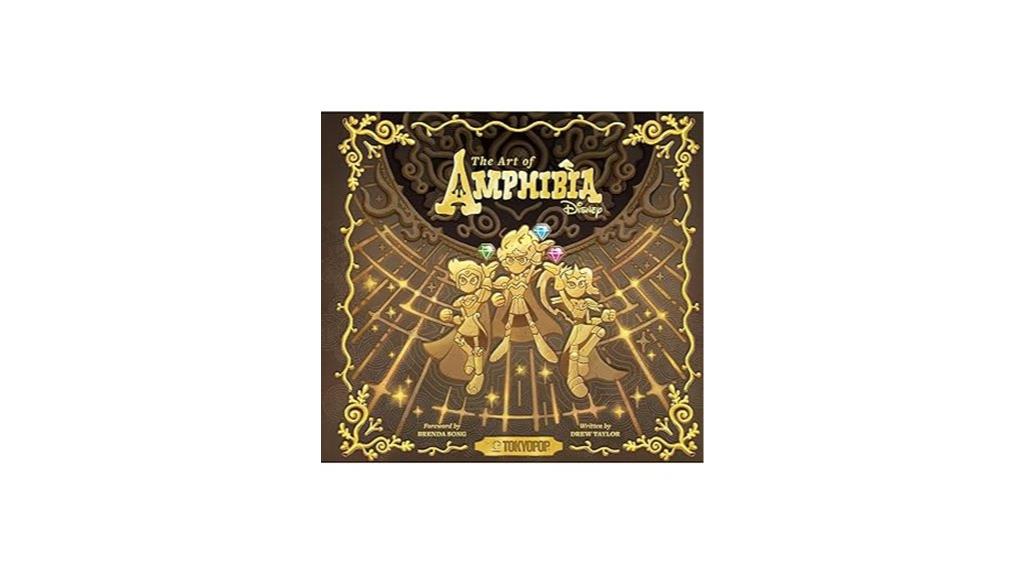
The Art of Amphibia stands out as an essential collection for dedicated fans and collectors, especially those who appreciate detailed artwork and behind-the-scenes insights. I find the vibrant backgrounds, character models, and storyboards truly stunning, capturing the series’ charm and authenticity. The book includes every episode, along with fun facts and development stories, making it a treasure trove for enthusiasts. While the design is beautiful, I wish it offered more pages and deeper insights from the creators. Overall, it’s a well-crafted, visually engaging book that celebrates the artistry behind Amphibia, perfect for fans enthusiastic to explore the show’s creative process.
Best For: die-hard Amphibia fans and collectors who appreciate detailed artwork, behind-the-scenes insights, and comprehensive series coverage.
Pros:
- Stunning and vibrant artwork, backgrounds, and character designs.
- Includes every episode with fun facts and development stories, offering a thorough overview.
- Well-packaged, high-quality physical presentation that appeals to collectors.
Cons:
- Limited text and detailed insights from creators, which could enhance the experience.
- Some wish for more pages and a larger size for a richer, more immersive reading experience.
- Slight imbalance between art and writing, with some sections feeling sparse or overly brief.
Happy Feet 2
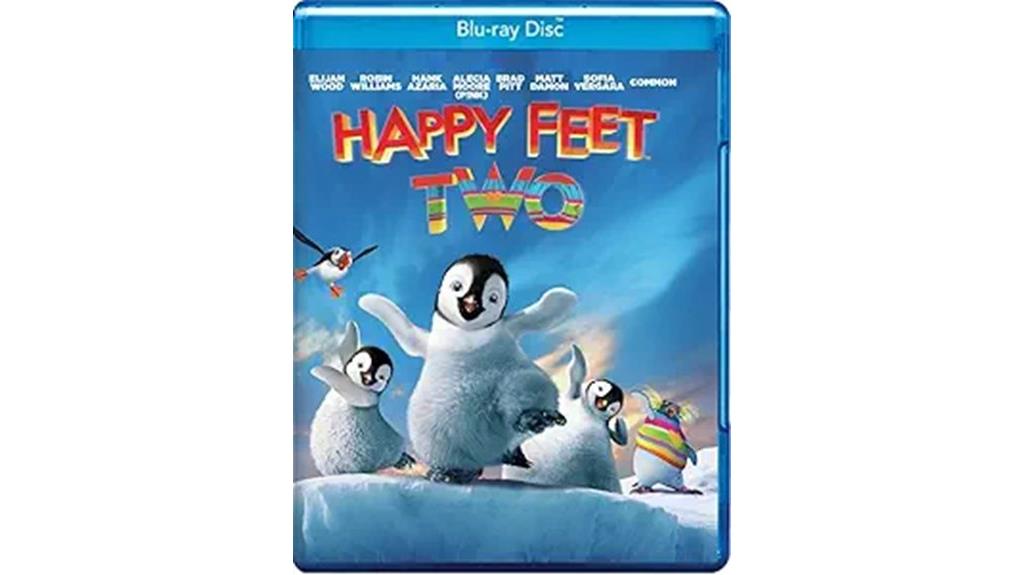
Are you looking for an animated film that combines stunning visuals with meaningful themes? Happy Feet 2 immerses you in Antarctica’s icy landscape, showcasing vibrant, detailed environments through exceptional 3D animation. It follows Mumble, Gloria, and their son Erik as they explore themes of self-discovery, diversity, and teamwork. The film’s lively cast, energetic musical numbers, and poetic messages create a rich, emotionally resonant experience. Despite its chaotic narrative, it offers a mesmerizing glimpse into penguin life and the resilience needed to overcome challenges. If you love visually breathtaking stories that celebrate nature’s magic and human (or penguin) connection, Happy Feet 2 is a must-watch.
Best For: fans of vibrant, visually stunning animated films that explore themes of self-discovery, diversity, and teamwork with a musical and poetic touch.
Pros:
- Exceptional 3D animation capturing the icy Antarctic landscapes and aquatic environments with vivid detail.
- Engaging musical numbers featuring a diverse cast and a soundtrack that celebrates cultural variety.
- Rich emotional depth and meaningful themes that appeal to both children and adults.
Cons:
- The chaotic narrative may be confusing or overwhelming for some viewers.
- Some critics initially reacted negatively, citing the film’s sprawling storyline.
- The complex thematic content might be less suitable for very young children expecting a simple story.
Wolf Children
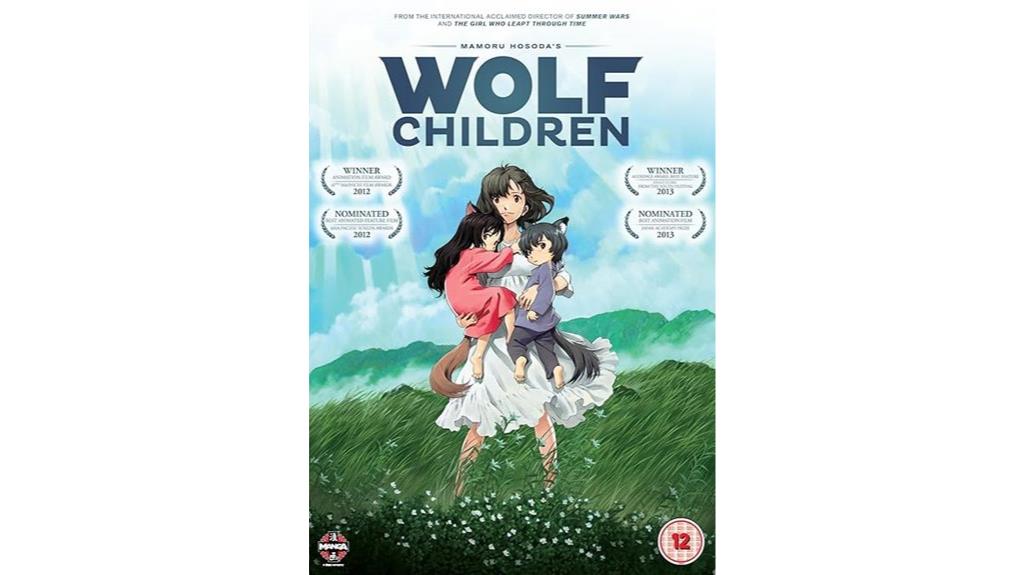
Wolf Children stands out as an animated film perfect for viewers who appreciate heartfelt stories about family, love, and self-discovery. I was moved by Hana’s journey as she raises her wolf-human children, Yuki and Ame, in a rural setting. The film beautifully captures the emotional struggles of parenting, identity, and letting go as the children choose their own paths. Its stunning artwork and emotional depth bring nature’s beauty to life, highlighting the bond between humans and the wilderness. This film’s honest portrayal of resilience and love makes it a must-watch for anyone seeking a touching, nature-inspired story that resonates beyond words.
Best For: fans of heartfelt animated films who appreciate themes of family, love, and self-discovery set against beautiful natural backdrops.
Pros:
- Emotionally engaging storytelling that resonates with a wide audience
- Stunning artwork and cinematography that vividly depict nature and character expressions
- Thoughtful exploration of parenting, identity, and independence with a heartfelt approach
Cons:
- Some viewers may find the pacing slow during certain segments
- Occasional use of anime clichés that might feel predictable to seasoned fans
- The scene implying intimacy between Hana and her wolf husband may be sensitive for younger viewers
Factors to Consider When Choosing Animated Nature Films
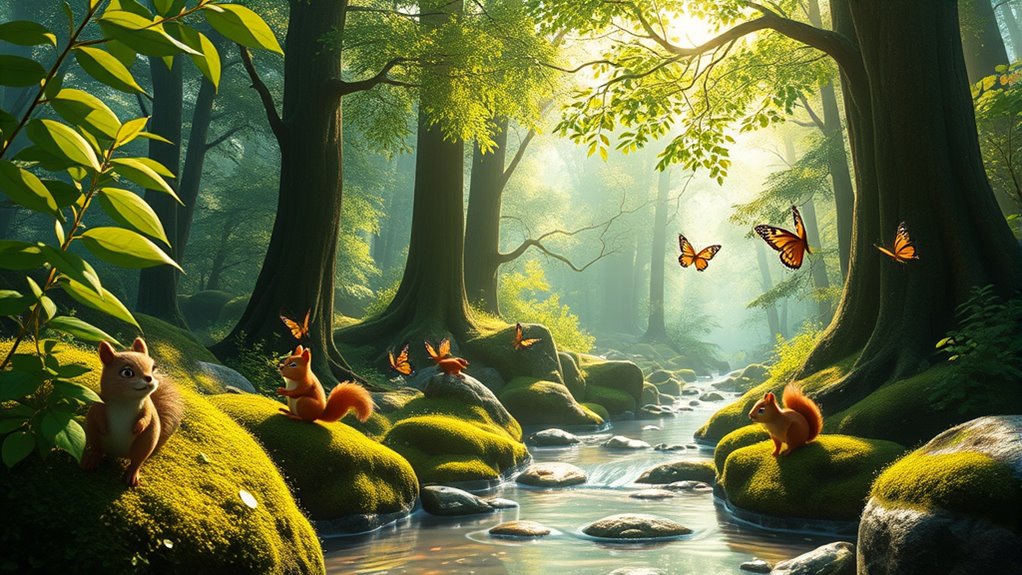
When selecting animated nature films, I always think about the visual quality and whether it matches my expectations, since stunning imagery makes a big difference. I also consider the educational content to guarantee it’s suitable for the viewer’s age and learning level. Finally, I look at features like durability, materials, and interactive options to get the best value and engagement from the film.
Visual Quality Expectations
Choosing animated nature films with high visual quality means looking for sharp, detailed images that faithfully reproduce natural environments and wildlife. Vibrant color palettes and realistic textures help immerse viewers in the scenery, making the experience more engaging. Advanced animation techniques like layered effects and dynamic lighting add depth and lifelike qualities to the visuals. Clear, high-resolution imagery is vital for appreciating fine details such as animal fur, water reflections, and foliage textures. Consistency in visual quality across scenes ensures a seamless viewing experience that keeps viewers captivated and enhances the educational value. When selecting a film, pay attention to the clarity and realism of the visuals, as these elements greatly impact the overall enjoyment and learning potential of the animated nature experience.
Educational Content Depth
High-quality visuals can captivate viewers, but the depth of educational content truly brings animated nature films to life. When choosing a film, I look for accurate information about animal behaviors, habitats, diets, and ecological roles, which enhances learning. The level of detail should match the target age group—enough to inform without overwhelming young viewers. Well-designed films often include factual narration, interactive elements, and supplementary materials that deepen understanding. Interesting facts, like population stats or unique adaptations, spark curiosity and help viewers remember key concepts. Striking a balance between entertainment and factual accuracy is essential, as it fosters respect and a genuine appreciation for nature. Ultimately, a film with rich educational content makes the experience both enjoyable and enlightening.
Age Appropriateness Level
How do you guarantee that an animated nature film is appropriate for your child’s age? First, check the film’s age ratings and viewer advisories to ensure they match your child’s developmental stage. Look for content with simple language and gentle themes suitable for young viewers, avoiding anything too complex or intense. It’s important that the humor, music, and storytelling are age-appropriate, fostering a positive experience without confusing or frightening your child. Seek out films that balance educational value with engaging visuals, keeping their interest without overwhelming them. Also, avoid films with graphic or frightening scenes that could scare or confuse younger children. By carefully considering these factors, you can select films that are both enjoyable and suitable for your child’s age.
Durability and Material
Since children tend to handle animated films frequently, selecting durable materials is essential to guarantee the product lasts over time. Look for films printed on thick, high-quality pages or made with sturdy plastic overlays—they can withstand frequent handling without tearing, creasing, or fading. Materials that are laminated or sealed offer extra protection against spills, dirt, and wear, extending the lifespan of the film. The construction details, such as layered cardboard or reinforced binding, also add to durability, ensuring the product remains intact through rough use. Choosing films made with resilient, high-quality materials not only prolongs their usability but also maintains visual clarity over the years. This way, you guarantee the animated nature films remain engaging and intact for your child’s continued outdoor adventures.
Interactive Features Offered
Have you ever wondered how interactive features can transform animated nature films into engaging learning tools? These features actively involve viewers, making the experience more immersive. Many films include movable images, touch-responsive elements, or augmented reality components that draw you in and encourage exploration. Some use lenticular printing or flip-book animations to create dynamic illusions of motion, boosting visual interest and educational value. Others incorporate quizzes, sound effects, or clickable hotspots that provide extra information about wildlife or habitats. Such interactivity helps maintain children’s attention, promotes hands-on learning, and sparks curiosity about the natural world. The quality and complexity of these features vary, with premium films offering more immersive experiences that deepen engagement and make learning about nature both fun and memorable.
Language and Subtitles
Choosing the right animated nature film means paying attention to its language and subtitle options. I look for films that offer subtitles in my preferred language to boost understanding and make the experience more immersive. It’s essential that these subtitles are professionally translated, ensuring accuracy and cultural relevance. If I have hearing difficulties or want to share the film with others, I check whether the subtitles are available for the hearing-impaired and if multiple language options are offered for multilingual audiences or learners. Clear, easy-to-read subtitles synchronized perfectly with the audio and visuals are a must. This attention to detail helps me enjoy the film fully, making the experience accessible, inclusive, and engaging for everyone.
Narrative and Storytelling
Ever wondered how a well-crafted story can transform an animated nature film into a truly mesmerizing experience? The key lies in storytelling that captivates and educates simultaneously. A strong narrative with a clear beginning, middle, and end helps explain complex ecological ideas in a way that’s easy to grasp and memorable. Including relatable characters, like animals with personalities or human-like struggles, creates emotional bonds that deepen understanding. Using storytelling devices such as conflict, resolution, and themes of survival or cooperation highlights crucial environmental messages powerfully. Striking a balance between factual accuracy and engaging storytelling keeps viewers both informed and entertained. When choosing an animated nature film, consider how its story enhances the overall experience—this often makes the difference between a good watch and a truly inspiring one.
Price and Value
When selecting an animated nature film, it’s important to weigh the price against the value it offers. I look for films that provide high-quality visual effects, educational content, and durability, ensuring I get the most out of my investment. A higher price often indicates superior animation, detailed information, and long-lasting materials, which is especially beneficial for dedicated enthusiasts or educational settings. Comparing costs with similar titles helps me determine if a film strikes a good balance between entertainment and learning. While budget-friendly options may be more affordable, they can sacrifice visual fidelity or supplemental content. Investing in well-made, durable films pays off over time, as they can be enjoyed repeatedly and used as reliable educational tools for years.
Frequently Asked Questions
How Do Animated Nature Films Impact Environmental Awareness?
Animated nature films really boost my environmental awareness by making complex ecological issues engaging and easy to understand. They inspire me to appreciate the beauty of the natural world and motivate me to take action to protect it. Seeing vibrant ecosystems come alive on screen reminds me how fragile our environment is, encouraging me to make more eco-friendly choices in my daily life. These films truly deepen my connection to nature.
Can These Films Be Used for Educational Purposes Effectively?
These films can be incredibly effective educational tools. I’ve seen them transform how students see nature, making complex ecosystems feel like they’re right there with us. They simplify tough concepts and ignite curiosity, often more than traditional textbooks. When I use animated nature films in lessons, I notice engagement skyrockets. They’re like a window to the wild that opens minds and inspires action—truly a game-changer for environmental education.
What Age Groups Benefit Most From Animated Nature Documentaries?
I believe children ages 3 to 12 benefit most from animated nature documentaries. Young kids are naturally curious and love vibrant visuals, which these films provide. They help develop an early appreciation for nature and spark learning about wildlife and ecosystems. Older kids and even teenagers can find engaging content that deepens their understanding of the environment. Overall, these films are a fantastic tool for inspiring a love of the outdoors across various ages.
Are There Any Notable Differences Between 2D and 3D Animated Nature Films?
Imagine 2D films as charming hand-drawn sketches, whispering stories with a nostalgic wink, while 3D films feel like stepping into a lush, animated jungle with vibrant depth and realism. I find 3D animations more immersive, offering detailed textures and lifelike movements, but 2D has a timeless artistic flair that charms. Both bring nature to life beautifully, just with different flavors—like a classic painting versus a modern sculpture.
How Do Filmmakers Ensure Accuracy in Animated Wildlife Portrayals?
Filmmakers guarantee accuracy in animated wildlife portrayals by collaborating with experts like biologists and ecologists, studying real animals and their behaviors. They use detailed reference footage and scientific data to create realistic movements and environments. I find that this dedication to authenticity helps bring the natural world to life convincingly, making the animations both educational and enthralling. It’s a fascinating process that blends art with science to accurately depict wildlife.
Conclusion
If you’re looking to bring the wonders of nature right into your home, these films are a fantastic start. They capture the beauty and spirit of the outdoors in ways that inspire and delight. As the saying goes, “A picture is worth a thousand words,” and these movies prove that animation can truly bring the outdoors to life. So, immerse yourself and let these films remind you of nature’s incredible magic.
